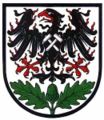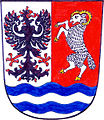Wenceslas eagle
The Wenceslas eagle , actually Saint Wenceslas eagle , is a common figure in heraldry and a heraldic animal with its own name. This form of an eagle can only be found in the heraldry and sealology of the Central Bohemia and Trentino region .
He is seen as the symbol of the patron saint of the Bohemian land , Wenceslaus of Bohemia . St. Wenceslas, Bohemian prince from the ruling Přemyslid family in the first half of the 10th century, was canonized after his martyrdom . His own brother Boleslav I murdered him. It is believed that in the coat of arms of Wenceslas of Bohemia a black eagle with gold weapons was depicted in a silver field. Silver feathers on the wings and red flames give the eagle its second name: Flame Eagle . Other sources speak of the oldest heraldic animal and describe the black eagle in silver sprinkled with golden flames, gold armored and golden clover stalks over the chest. The wings were probably not painted in the usual way. Instead, golden, ringing metal plates were attached to the wings (cutlery).
A seal from King Přemysl Otakar from 1192 shows a female eagle . The color of the eagle does not appear from the seal. It is assumed that there is a black eagle on a silver field. Emperor Rudolf II. Renewed market rights privileges on August 16, 1591, as did King Ladislaus as early as 1457 and others in 1787. The seals used showed a crowned half eagle over a large initial "W". In addition the inscription in capital letters "+ SIGILLVM. OPPIDI. RAWSENBUC. ANNO DOMINI: 1591 ". The oval seal had a diameter of 32 × 30 mm. The certificate for the market coat of arms from August 1591 contains the description of Rausenbruck . After that, the place has a shield divided by silver into red, with a crowned and gold-armored eagle with a red tongue growing in it above, the golden "W" below. The St. Wenceslas eagle was most likely mistakenly interpreted as the Moravian national eagle by the market town stamps of the 19th and 20th centuries . This was misinterpreted from the seal and dished accordingly . The eagle growing in the upper part of the shield became a shield-filling one. The “W” from the lower part of the shield, which characterizes the Wenzel eagle, only moved as a small “w” appendage between the tail feathers. Bilingual stamps used after the First World War until 1938 were designed in the same way.
Margrave of Moravia, Přemysl Otakar II. Had already used the double-tailed lion in the coat of arms of the dynasty and the Wenceslas eagle as a national symbol in the first half of the 13th century. In a battle in 1142 against the Moravian prince Konrad, the imperial princes had the Wenceslas eagle on their pennants.
In Trento, where it was introduced by Prince-Bishop Nikolaus Abrein (1338–1347), this shape probably overlays the older Tyrolean eagle (red with gold wing clips in silver), which is proven as early as 1205 (color 1271/1286).
Examples
Trentino (current)
Central Bohemia coat of arms
literature
- ^ Maximilian Gritzner : Regional and heraldry of the Brandenburg-Prussian monarchy. History of their individual parts of the country, their rulers and coats of arms. Heymann, Berlin 1894, p. 26.







